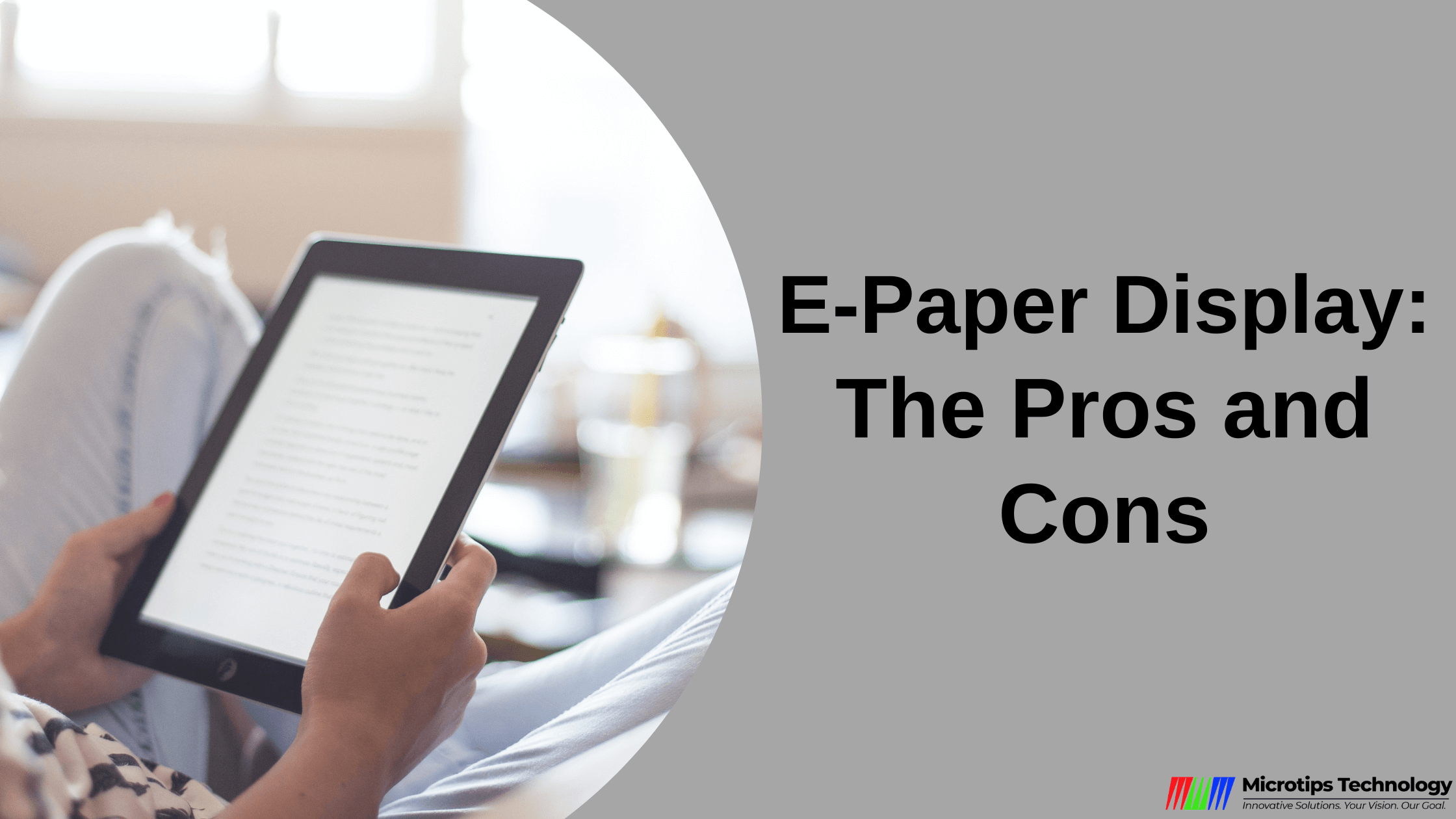The majority of people assume that e-readers are electronic reading devices with LCD screens. Since most smartphones, tablets, and laptops utilize such technology. E-Ink, on the other hand, is a different kind of e-reader screen technology that is available. Tiny microcapsules containing pigment particles with electrical charges make up E-Ink screens. Then, two conductive plates are placed on top of the microcapsules. The particles move and alter the screen’s look when the plates are positively or negatively charged.
The development of the E-paper is definitely a great success due to the various ease that has already been praised in our previous blog, WHAT ARE THE ENVIRONMENTAL BENEFITS OF E-PAPER?
In today’s blog, we will discuss the pros and cons of an E-paper display.
Before starting, let us have a recap and understand the technicalities behind E-display.
A QUICK RECAP’
Electronic paper, also known as e-paper display, electronic ink or e-ink display, or electrophoretic display, is a form of digital technology that imitates the eye-catching visuals of your daily newspaper. Among these different names, “e-ink” alludes to the company “E Ink Corporation,” which developed the electronic ink that helped make these displays popular.
The word “electrophoretic displays” refers to devices that operate on the electrophoresis principle. The name “e-paper displays” refers to how similar these displays are to newspapers, which provide clarity to the information and have a variety of uses.
APPLICATIONS OF E-PAPER DISPLAY
E-paper displays have been available for a while now. Due to their low power, low weight, and flexible characteristics, e-paper displays have found use in various applications across several industries. They were first primarily employed by e-book readers. The other primary uses for electronic paper are:
1. E-readers
E-readers are the most widely used e-paper application. Because of its high reflectivity, broader viewing angle, and extremely low power consumption, electronic paper display technology is commonly employed in e-readers.
2. Digital Signage
For digital signs and public information displays, electronic paper is ideal for indoor and outdoor applications.
3. Supply Chain Management
Supply chain management extensively uses e-paper displays to track and monitor real-time items. The monitoring labels can increase transparency and visibility in logistics monitoring.
4. Retail Labels
Since they offer a less expensive alternative to conventional paper label technologies, electronic paper displays are commonly employed in retail labels.
E-paper displays are also frequently used in menu boards, price boards, wayfinding, gas station price signs, digital ID badges, and transit signage.
PROS OF E-PAPER DISPLAY
E-ink technology has advanced significantly, yet it still lacks the responsiveness of LCD, LED, and other standard displays. E-ink displays reportedly take “15 to 20 seconds to power up completely,” not to mention a few seconds to wake them from sleep mode, according to users. The pros of E-paper display are as follows.
1. Easier on the eyes: E-ink screens have many benefits compared to other display types. They are easy on the eyes because, among other things, they more nearly resemble printed paper.
2. Less Power Consumption: E-ink displays also use less energy than other panel types, such as LCDs, because of their lower power requirements. This is so that the e-ink only consumes energy when the screen’s image is changed. On the other hand, LCDs need the power to keep their screens lit. This makes e-ink displays a far more cost-effective option, especially for gadgets like e-readers that are used for extended periods of time.
3. Readable in direct sunlight: E-ink displays are also easily readable. This is because e-ink pigments reflect light rather than emit it. On the other hand, LCD panels usually fade in the sunshine.
4. Adaptable: E-paper displays can be used in several applications since they are adaptable. E-ink is being used, for instance, to create smartwatches and other wearable technology.
CONS OF E-PAPER DISPLAY
1. Low refresh rate: The low refresh rate of e-ink is one of its most significant drawbacks. This means that updating e-ink displays can be a lengthy process. An e-ink display, for instance, may take several seconds to transition from black to white. Users who are used to the immediate satisfaction of LCD screens may find this frustrating. For individuals just reading text, though, the low refresh rate won’t be a significant problem because they will only frequently alter the image on the screen.
2. Limited color palette: Another drawback of e-ink is that its color options are only limited to black and white. While some devices employ color e-ink, they are less prevalent than those with monochrome screens. This restriction results from the way e-ink functions. The colors that can be exhibited are constrained by the fact that the pigments in e-ink can only be orientated in two ways. However, the black-and-white color scheme is sufficient for many users. And because it might lessen eye strain, some users enjoy it.
FUTURE OF DISPLAYS
E-Paper displays are readily available nowadays from many different brands. Electronic paper displays (EPD) have lately been made available by Microtips USA for commercial and industrial applications. Screen sizes for these bistable displays range from 1.49 to 13.2 inches, with resolutions ranging from 152(H), 152(V), to 960(H)680(V) pixels.
They guarantee exceptional readability and visibility from all viewing angles and provide all the advantages mentioned in this essay. The MicroTips team will assist you in comprehending these e-paper displays’ benefits and usefulness for your applications. You need to contact the staff immediately to review your needs.

